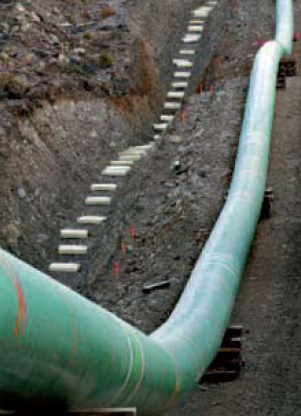|
Home | Consulting | Training | Expert Witness | Failure Analysis | Design Review | Corrosion Test | Corrosion Software | Protective Coatings | Materials Selection | Cathodic Protection | >>> | ||
|
Design and Operation of Pipeline Cathodic Protection Systems - Design, Installation, Operation, Maintenance, Survey and Monitoring |
||
|
Course Outline |Who Should Attend |Registration |In-House |On-Demand |Online Courses |PPT Slides+Testbank |Course List | Why WebCorr |
||
| Course Overview | ||
|
This course is available for in-house training, online and distance learning worldwide. It can also be customized to meet the specific needs of your organization.
|
||
|
||
| Course Outline | ||
|
1.1 Corrosion and cathodic protection
2.1 CP Design objectives
2.4.1
Literature Sources 2.5 Calculation of Cathodic Protection Circuit Resistances
2.5.1
Resistance of a Single Rod Shaped Anode Positioned
2.6 Calculating System Capacity & Life
3.1 Sample cathodic protection designs
3.2 Computer software for cathodic protection
design:
CP-Compass
4.1 CP Interference
5.1 Design of Performance Monitoring
Facilities
6.1 CP system performance evaluation
6.1.10 Cathodic protection modeling and corrosion prediction with
CP-Compass
7.1 Troubleshooting Cathodic Protection
Systems 7.4 End of course examination with design project
|
||
|
Course Outline |Who Should Attend |Registration |In-House |On-Demand |Online Courses |PPT Slides+Testbank |Course List |
||
| Who Should Attend | ||
Successful completion of this corrosion course helps participants prepare for their NACE certification examinations at the Corrosion Technician, Corrosion Technologist and Senior Corrosion Technologist levels.
|
||
| Registration for This Corrosion Course | ||
| In-House Training Corrosion Courses | ||
|
If you are concerned with corrosion in your business, in-house training is a great solution to train a group of employees from design, production, operation, quality assurance, inspection and maintenance, and technical sales and support on corrosion control and corrosion prevention technology. The contents of all corrosion courses can be customized to fit your organization's needs.
There is no minimum or maximum number of participants required for in-house training corrosion courses. We conduct the in-house training corrosion course at your company's premises and at a time convenient to your company. Requests for in-house training corrosion courses from overseas countries are also welcome.
Click
here to contact us
for a quotation. |
||
| Corrosion Course-On-Demand | ||
|
All our publicly scheduled corrosion short courses are conducted once a year. However, you do not need to wait for one year if you have missed any of the publicly scheduled corrosion courses as we have this unique corrosion course-on-demand scheme: we will conduct the course just for you on an one-on-one basis at a time and in a location convenient to you. This option costs significantly less than a full-scale in-house training program.
Click here to contact us for a quotation for taking this course as course-on-demand.
|
||
| Online and Distance Learning Corrosion Courses | ||
|
Click here to register this corrosion short course for online or distance learning. |
||
| PowerPoint Slides and Test Banks for Trainers, Instructors, Tutors, University Lecturers and Professors | ||
|
If you are involved in teaching or training, you may wish to purchase a complete set of the trainer's package for this training course. The trainer's package comes complete with ready-to-use PowerPoint slides (fully editable) and test bank (with answer keys). These ready-to-use PowerPoint slides contain high quality color photographs, illustrations, animations, audio and video clips. The test bank contains questions in four categories: (1) true or false, (2) multiple choice, (3) calculation, and (4) reasoning and open-ended discussions. The trainer's package is suitable for in-house training and university teaching. This is exactly the same package that WebCorr uses to deliver our current training course. The one-time lump sum fee allows your organization to use the training package and also modify it. For example, your organization may modify the course contents and re-name/re-brand the course under your organizationís name. WebCorr only retains the copyright of the original PowerPoint slides and test bank.
Click here to contact us if you need more information on the trainer's package.
|
||
|
Course Outline |Who Should Attend |Registration |In-House |On-Demand |Online Courses |PPT Slides+Testbank |Course List |
||
|
Copyright © 1995-2025.. All rights reserved. |
||
 Maintaining
the ageing infrastructure such as underground pipelines is a challenge
to facility owners worldwide. Understanding why and how cathodic protection works or fails can help the operator formulate
appropriate strategy in managing the pipeline corrosion problems. This
5-day course covers both the fundamentals and practices in the design,
installation
operation, maintenance, survey, monitoring, and trouble-shooting of pipeline
cathodic protection systems.
Maintaining
the ageing infrastructure such as underground pipelines is a challenge
to facility owners worldwide. Understanding why and how cathodic protection works or fails can help the operator formulate
appropriate strategy in managing the pipeline corrosion problems. This
5-day course covers both the fundamentals and practices in the design,
installation
operation, maintenance, survey, monitoring, and trouble-shooting of pipeline
cathodic protection systems.